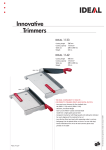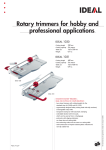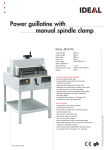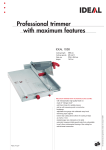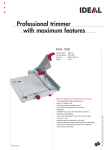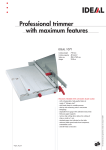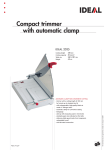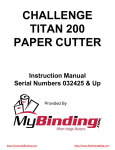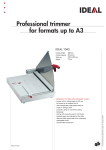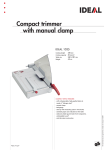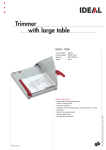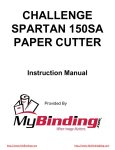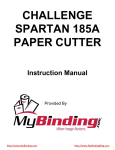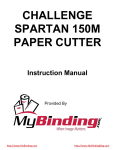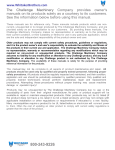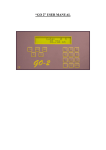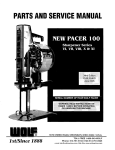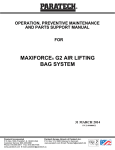Download CT Service Manual - Copy Finishing Systems
Transcript
Serial Numbers 032425 & Up TECHNICAL SERVICE AND PARTS MANUAL TITAN 200 PAPER CUTTING MACHINE Sold and Serviced by The Challenge Machinery Company 6125 NortonCenter Drive Norton Shores, MI 49441-6081 USA ChallengeMachinery.com F.200-CT August 2003 1.0 Introduction 1.0 Introduction THIS MANUAL is designed to help you get the most from your Challenge equipment. Keep this manual in a safe, convenient place for quick reference by operators and service personnel. SAFETY ALERT! This symbol means CAUTION: Personal safety instructions! Pay special attention to the instructions in bold type. Personal injury may result if the precautions are not read and followed. FOR PARTS AND SERVICE contact the Authorized Challenge Dealer from whom you purchased your machine. Use the illustrations and parts lists at the back of this manual to identify the correct parts needed. Always give the SERIAL NUMBER and MODEL of your machine to insure the correct parts are sent as soon as possible. Challenge® is a registered trademark of The Challenge Machinery Company• 6125 Norton Center Drive • Norton Shores, MI 49441-6081 Copyright© 2003 by The Challenge Machinery Company. All rights reserved. Printed in the U.S.A 2 1.0 Introduction TABLE OF CONTENTS 1.0 Introduction....................................................................................................................................... 2 2.0 Safety ............................................................................................................................................... 4 2.1 Precautions .................................................................................................................................. 4 2.2 Power Lockout Procedure............................................................................................................ 4 2.3 Warning Label Definitions ............................................................................................................ 5 3.0 Maintenance Guide .......................................................................................................................... 6 3.1 Troubleshooting ........................................................................................................................... 7 3.2 Description of Error Messages..................................................................................................... 8 3.3 Sensor Data Abbreviations .......................................................................................................... 9 3.4 Routine Maintenance ................................................................................................................. 10 3.4.1 Weekly ................................................................................................................................ 10 3.4.2 Monthly ............................................................................................................................... 10 3.4.3 Yearly.................................................................................................................................. 10 3.5 Checking/Changing the Hydraulic Fluid..................................................................................... 10 3.5.1 Recommended Hydraulic Oils ............................................................................................ 11 3.6 Oil and Grease ........................................................................................................................... 12 3.7 Adjustments ............................................................................................................................... 14 3.7.1 Electric Eye Alignment........................................................................................................ 14 3.7.2 Backgauge Gib Adjustments .............................................................................................. 15 3.7.3 Squaring the Backgauge .................................................................................................... 16 3.7.4 Clamp Pressure Adjustment............................................................................................... 17 3.8 Cleaning ..................................................................................................................................... 18 4.0 Schematics & Parts Lists................................................................................................................ 20 4.1 Main Assembly – Front View ..................................................................................................... 20 4.2 Main Assembly – Right Side View ............................................................................................. 22 4.3 Main Assembly – Table Asm. View............................................................................................ 24 4.4 Main Assembly – Tilt Shield / Electric Eyes ............................................................................... 26 4.5 Hydraulic Power Unit – 60 Hz .................................................................................................... 28 4.6 Hydraulic Power Unit – 50 Hz .................................................................................................... 29 4.7 Hydraulic Manifold Assembly & Schematic ............................................................................... 30 4.8 Power Panel Label ..................................................................................................................... 31 4.9 Electrical Schematic – Tilt Shield Machines .............................................................................. 32 4.10 Electrical Schematic – Electric Eye Machines ......................................................................... 34 4.11 Power Panel Assembly ............................................................................................................ 36 4.12 Control Console Assembly....................................................................................................... 38 4.13 Knife Latch Assembly .............................................................................................................. 39 4.14 Line Light Assembly................................................................................................................. 40 4.15 Cut Button Assembly ............................................................................................................... 41 4.16 Fuse Value and Function ......................................................................................................... 42 4.17 Control P.C. Assembly ............................................................................................................. 43 4.18 Electric Eye Assembly ............................................................................................................. 44 4.19 Titan 200 Floor Plan................................................................................................................. 48 5.0 Safety Systems Test ...................................................................................................................... 50 3 2.0 Safety 2.0 Safety 2.1 Precautions • • • • • • • • • • • • • • • • This machine is designed for one-person operation. Never operate the machine with more than one person. Safe use of this machine is the responsibility of the operator. Use good judgment and common sense when working with and around this machine. Read and understand all instructions thoroughly before using the machine. If questions remain, contact the dealer from which you purchased this machine. Failure to understand the operating instructions may result in personal injury. Only trained and authorized people should operate this machine. DO NOT ALTER SAFETY GUARDS OR DEVICES. They are for your protection. Severe personal injury may result. Disconnect power before cleaning or performing maintenance. See Section 2.2 Power Lockout Procedure. Observe all caution labels on this machine. Be sure the cutter is properly grounded. Be sure there is sufficient power to operate the cutter properly. Observe all caution plates mounted on this cutter. Keep foreign objects off table and away from cutter blade. BE EXTREMELY CAREFUL when handling and changing the cutter knife. Severe lacerations or dismemberment could result from careless handling procedures. Keep the floor around the cutter free of trim, debris, oil and grease. When replacing hydraulic parts, loosen the connections slowly to release pressure. Never loosen connections with the machine running. If the cutter sounds or operates unusually, turn it off and consult the troubleshooting section of this manual. If the problem cannot be corrected, have it checked by a qualified service person. CRUSH HAZARD, keep hand and fingers from under the clamp when clamping paper. Use Jogging Aid to load paper, and use the backgauge to push paper out before unloading. DO NOT REACH UNDER THE KNIFE AND CLAMP AREA! 2.2 Power Lockout Procedure For maximum safety while making adjustments or repairs to your machine, be sure to disconnect power to the machine. Disconnect the power plug from its socket Figure 1 - Main Power Disconnect 4 2.0 Safety 2.3 Warning Label Definitions The following warning labels are found at various locations on your machine. Read and understand the meaning of each symbol. If a label is lost from the machine, it should be replaced. HAZARDOUS AREA Disconnect power before cleaning, servicing, or making adjustments not requiring power. Do not alter safety guards or devices; they are for your protection. Replace all guards. Do not operate with any guards removed. SHOCK HAZARD Disconnect power before removing cover. Replace cover before operation. SHOCK HAZARD Disconnect power before removing cover. Replace cover before operation. SINGLE OPERATOR Do not operate with more than one person. 5 3.0 Maintenance Guide 3.0 Maintenance Guide NOTICE The instructions on the following pages are for the use of trained service personnel only! Attempting to perform repair and replacement procedures without proper training may cause machine damage or operator injury! PARTS CUSTOMERS: Parts with the express understanding that they are to replace parts found missing or no longer serviceable on equipment designed and/or manufactured at Challenge. The Challenge Machinery Company assumes no liability for any modification or alteration to any Challenge products, and any such modification or alteration to any Challenge product is not authorized by The Challenge Machinery Company. Any modification or alteration of any Challenge product will void any remaining warranty. 6 3.0 Maintenance Guide 3.1 Troubleshooting WON’T START Fuse Blown. Power cord disconnected. Main power switch not turned on. BACKGAUGE DISPLAY INACCURATE Preset circuit board malfunction. Encoder malfunction. Main circuit board malfunction. BACKGAUGE DISPLAY INACCURATE - BY CONSTANT AMOUNT Backgauge needs accuracy adjustment. Presetter malfunction. CUT BUTTONS PUSHED - WON’T CUT Check error codes (page 8). Obstruction between electric eyes (if equipped). Guard open (if equipped). Guard hasn’t been opened since last cut (if equipped). Hydraulic fluid low. Main relief valve setting off. Sequence pressure set wrong. Cut button defective. Motor relay defective. Knife latch solenoid defective. Knife down coil defective. Defective directional valve. Cylinder disconnected from cylinder bracket. Knife bar dirty or dry, lubricate knife guideways. Dirt in hydraulic system. CLAMP STARTS UP BEFORE KNIFE IS UP Clamp Up Sequence Valve setting incorrect/defective. CONCAVE CUTTING - ENDS WIDE, CENTER NARROW Excessive moisture at edges of paper. CONCAVE CUTTING - VARIATION FROM TOP TO BOTTOM Soft paper not firmly clamped. Knife dull or incorrectly grounded. ERRATIC OPERATION-POWER LOSS Hydraulic fluid low. Dirt in hydraulic system. Oil bypassing piston in cylinder . Voltage supply is low. KNIFE DRIFTS DOWN Knife latch not engaging or damaged. KNIFE HESITATES OR STALLS Dull knife. Main relief valve setting off. 7 3.0 Maintenance Guide Paper clamped too tight - lower clamp pressure reducer setting. Cylinder seals worn - leaking pressure. Hydraulic fluid low. Voltage supply is low. KNIFE STARTS DOWN BEFORE CLAMP REACHES TABLE Knife down sequence valve setting incorrect. Clamp pressure set too low. KNIFE WON’T RETURN UP Solenoid defective. Limit switch out of adjustment. Cylinder disconnected from bracket. Sequence valve misadjusted. PUMP-MOTOR WON’T SHUT OFF Knife/Clamp Up Limit switch not activated - readjust. Motor relay contacts welded. 3.2 Description of Error Messages Message Backgauge Failure Backgauge doesn’t move Backgauge at Limit Clamp Down Failure Backgauge is all the way forward or backward Bad program chip Clamp failed to return to up position within 7 seconds Clamp failed to come down Clamp or Knife Down Clamp or knife stayed down DATA IS OUT OF RANGE The number is outside the limits of the machine Motor starter was OFF when it should have been ON Motor starter was ON when it should have been OFF Latch prox. ON when it should have been OFF Cheksum Error Clamp Up Failure Motor Starter Failure 1 Motor Starter Failure 0 Knife Latch Failure 1 Knife Latch Failure 0 Knife Down Failure Knife Up Failure Knife at Both Limits 8 Description Latch prox. OFF when it should have been ON Knife failed to come down within 4 seconds Knife failed to return within 1.17 seconds Knife up and down prox. Switches are on at the same time Test Mechanical bind; encoder failure; main pcboard; blown fuse Replace EEPROM Clamp up sequence valve; solenoid (cut) valve Solenoid valves; low voltage, low pressure No main pressure; stuck solenoid valve Informational error Defective motor contact switch Defective motor contact switch Loose solenoid wire; mechanical bind; knife up prox. Switch out of adjustment; defective prox. Switch Low main pressure; low voltage; knife down sequence valve Mechanical bind; solenoid (cut) valve Prox. Switches; broken knife bar components 3.0 Maintenance Guide Message Description Lubricate Machine Lubricate machine alarm Memory Failed A memory error occurred during test Should only occur during initial assembly otherwise is an encoder error Tried to change a locked channel Tried to link two channels together and the linked channel is locked Selected cut position beyond limits of machine Backgauge failed to move to programmed position within +/.oo5 Encoder wires 9 & 10 are reversed Memory Locked Next Channel Locked Number Outside of Limit Positioning Error Remove Obstruction Obstruction is blocking electric eyes, or electric eyes are not functioning properly When a math operation yields a negative number Console key was pressed while backgauge was moving Timing error in either up or down cycled Sharpen knife alarm Console Key shorted Result is Negative Send Cancelled Sequence Error Sharpen Knife Shorted Key Error Test Have machine lubricated Replace encoder Operator error; false clamp limit Mechanical bind; encoder failure; main pcboard; leadscrew thrust washers loose; gibs loose Remove obstruction, check alignment of eyes, check all electric eye connections Operator error; key board failure Low main pressure; any sequence valve Have knife sharpened Operator error; defective keyboard ** If error codes cannot be reset by depressing the clear key, the power will have to be turned OFF and ON** 3.3 Sensor Data Abbreviations Abbreviations LEFTCUT RGHTCUT KNFLAT HYDMOT R KNFDWN Standby 0 0 0 *1 1 Description Left Cut Button Right Cut Button Knife Latch Proximity Switch Motor Starter Relay Status Knife Down Proximity Switch PRESET 1 Preset Sensor CUTSOL 0 Cut Valve UNLOAD 0 Unload Valve KNLATSOL 0 Knife Latch Solenoid Location Lower front of table Lower front of table Left side of cutter opening Right side of power panel Inside of cutter opening, right side Rear of cutter, under left side of table Solenoid Valve on left side of manifold Solenoid Valve* (not in use yet) Inside of cutter opening, left side 9 3.0 Maintenance Guide CLAMPUP 1 Clamp up Proximity Switch HYDUP 1 Hyd. Clamp Up Proximity KNFUP 0 Knife Up Proximity Switch CUTBTN EYES / GUARD HYDMOT O N.C. LTLINE 0 1 0 0 1 Cut Button Electric Eyes OR Front Guard Hydraulic Motor Relay Output No Connection Line Light Output CBTNLIT *On when pump is running. 0 Cut Button Light Inside rear of cutter opening, left side At bottom of clamp cylinder Inside of cutter opening, left side On display console In front of cutter opening. Top right side of main pcb Inside rear cutter opening, left side In display console 3.4 Routine Maintenance DISCONNECT POWER before making any adjustments or lubricating. See page 4, SAFETY PRECAUTIONS, for Power Lockout Procedure. This machine should be placed on a regular maintenance schedule. A clean, lubricated machine will run longer, smoother, cut more accurately, with less downtime and fewer costly repairs. Schedule lubrication both early in the day and early in the week. This allows the lubricants to work into the machine. Lubrication at the end of the day or week allows the lubricants to run off without any benefit to the machine. The following guidelines will help you set up a regular maintenance schedule: 3.4.1 Weekly Clean — Clean off old, dirty excess grease. Remove the lower front panel cover and clean accumulated dust off valves, hoses and connections. Built-up dust increases operating temperatures, which causes premature wear to all hydraulic components. Hardware — Remove the lower front panel cover, rear panel cover, and top hood to check all nuts and bolts for tightness. Loose hardware is the cause of most component wear and in the electrical area could cause short circuits and/or shock. Hydraulic Fluid — Low fluid level causes excessive heat and wear on the system. Check the fluid level as described in section 3.5 below. Oil and Grease — See section 3.6 3.4.2 Monthly Backgauge Squaring — See section 3.7.3 3.4.3 Yearly Change Hydraulic Fluid — See section 3.5 3.5 Checking/Changing the Hydraulic Fluid The hydraulic fluid level should be checked weekly. To check, remove the lower rear cover and unscrew the cap on top of the tank (Figure 2). 10 3.0 Maintenance Guide Dip Stick Figure 2 Fluid level should be at 1/8” from the end of the dip stick (check with dip stick cap screwed in). Add fluid if necessary but avoid overfilling as this could cause leakage when hot. Replace the rear panel when finished. The hydraulic fluid should be changed AT LEAST ONCE-A-YEAR or after every 1,000 hours of operation. NOTE: Failure to change oil when needed can damage seals in the cylinders, pump, and valves. Empty the hydraulic tank and refill with 1 gallon of International Standards Organization Viscosity Grade 100 (ISO VG 100) rust, oxidation, and foam inhibiting hydraulic fluid (Challenge part no.: S-1991). NOTE: NEVER use automatic transmission fluid or brake fluid as a substitute for the correct hydraulic fluid. A table of various manufacturers and their equivalents is listed below. 3.5.1 Recommended Hydraulic Oils Use one of the recommended oils or an ISO VG 100 Hydraulic Fluid equivalent only. Oils other than the recommended type will cause seals and O-rings to deteriorate. Unsafe operating conditions will result. Oil Name Rykon No. 100 Duro AW Oil 465 AW Machine Oil 100 Pacemaker XD No. 100 Super Hydraulic 100 Nuto H-100 Harmony 100 AW HO 2A Hydraulic Oil DTE No. 18 Pennzoil AW 100 Magnus A Oil 215 Tellus 100 Energol HLP 100 Industron 100 Sunvis 851 WR Rando HD 100 Unax AW 100 Distributor AMOCO Arco Chevron Citgo Conoco Exxon Gulf Lubriplate Mobil Pennzoil Phillips Shell Sohio Std. Oil Indiana/Boron Sun Oil Co. Texaco Union Oil Co. 11 3.0 Maintenance Guide 3.6 Oil and Grease Turn the power off and disconnect the power cord. Open the front guard (if equipped) and open the top hood for access. Parts requiring oiling are marked with red paint. See figures Figure 3 through Figure 10 starting on page 12 for oil and grease locations. Figure 3 through Figure 5 require the knife and clamp be in the up position. Figure 6 through Figure 10 require the knife and clamp be down. Wipe off any old or excess grease. Use any brand-name type of grease or light oil to lubricate. It may be necessary to use the supplied grease brush to access some locations. Note: the leadscrew may be lubricated with grease or oil. Oil has a tendency to run off and must be lubricated more frequently; grease tends to collect paper dust and must be cleaned off periodically. Grease Oil Figure 3 – Knife Bar Link – L.H. Side, Upper Figure 4 – Knife Bar Link – R.H. Side, Upper 12 3.0 Maintenance Guide Figure 5 – Knife Bar Figure 6 – Knife Bar Link – L.H. Side, Lower Figure 7 – Knife Bar Link – R.S., Lower Knife Bar Knife Cylinder Bracket, Upper 13 3.0 Maintenance Guide Figure 8 & Figure 9 –Clamp Guides Figure 10 – Leadscrew and Backgauge Guide 3.7 Adjustments Several of the following tests require the machine to be operational for checking and adjusting. Be very careful that tools and other people are clear of moving parts and that the cutter is not accidentally operated while adjustments are being made. Whenever working on the machine, disconnect the power and lock it out (see SAFETY PRECAUTIONS, page 4) unless the directions specifically require the machine to be powered. 3.7.1 Electric Eye Alignment If your machine is equipped with electric eyes, the alignment can be checked as follows: Turn on the power switch, and make sure there are no obstructions between the electric eyes. • • 14 If the green and yellow lights on the electric eyes are on solid, then the eyes are in proper alignment. If the red light is on and the yellow light is off or flashing, then the eyes either blocked or not aligned properly. 3.0 Maintenance Guide If alignment is necessary, loosen the screws that attach the electric eye brackets to the table extensions. Adjust until the green and yellow lights are on solid as described above and tighten screws. 3.7.2 Backgauge Gib Adjustments If the backgauge does not stay squared or jumps up and down when jogging paper against it, the backgauge gib screws are probably loose or worn. To Adjust: 1. Send the backgauge near the rear of the table. 2. Turn off the power and disconnect the power cord. 3. Remove the leadscrew cover under the table. 4. Loosen the two side gib screws and the bottom nylon guide screws (Figure 11, next page). Gib Screws Nylon Guide Screws Figure 11 5. Tighten the bottom, nylon guide screws until they just touch the guide. Do not overtighten or they could cause the backgauge to bind. 6. Similarly, turn the side gib screws in until they just touch the guide. Lock in position with the jam nuts. 7. Run the backgauge back and forth the length of the table using the backgauge glide control. Check for any binding. Readjust if necessary. NOTE: The screws should be tightened to hold the backgauge square against the guide rail. Excessive tightening will cause the backgauge to bind and cause premature wear of all components. 15 3.0 Maintenance Guide 3.7.3 Squaring the Backgauge Figure 12 To test if the backgauge is square, place a small lift of paper against the left side of the backgauge (but not against the side guide) and make a cut. Now, leave the backgauge in the same position, flip the lift over and push it against the right side of the backgauge (but not against the side guide). Make another cut to see if any of the paper will trim off. Run two checks, one starting on the left and moving to the right; the other, moving from the right to the left. If paper is trimmed in either sequence, the backgauge is out of square. 1. Make sure the backgauge gibs are set properly (see section 3.7.2 ). NOTE: Gib adjustments are not necessary on initial machine set-up as gibs have been adjusted at the factory. 2. Remove the rear plexiglass table cover. 3. Loosen the jam nuts on the backgauge adjusting screws (Figure 13). Adjusting Screws with Jam Nuts Figure 13 4. Back off the adjusting screw on the side that the trim occurred and tighten the other. 5. With the squaring screws tight, make another test. Continue to adjust and test until no trim occurs when testing either sequence. 6. Replace the rear plexiglass table cover. Note: Once the backgauge is square, restore power to the machine and check the backgauge accuracy (see the Titan 200 Operator manual) to make sure it is accurate. 16 3.0 Maintenance Guide 3.7.4 Clamp Pressure Adjustment Adjust the clamp pressure reducer (Figure 14) to the desired setting. It is factory preset at 800 psi. Read the gauge with the clamp down and as the knife begins to move down. Loosen the jam nut on the valve stem. With an allen wrench, turn the stem clockwise to increase pressure and counterclockwise to decrease pressure. Note: When cutting pressure sensitive paper, you may want to reduce the clamping pressure (400 psi minimum) to prevent marking the paper. Clamp Pressure Reducer Figure 14 DO NOT set the clamp pressure below 400 psi. Severe lacerations or dismemberment could result! The knife and clamp system loses sequence at settings below 400 psi and the knife could come down before the clamp. 3.7.4.1 Optional Electronic Clamp Pressure Control Adjustment The electronic clamping control option allows the convenience of changing the clamp pressure at the control console. The pressure is controlled by use of the up and down arrow keys, 0 being the lowest - 15 the highest; and is indicated in the upper right hand corner of the display. Note: To turn the electronic clamp control option on or off, enter the Maintenance Mode and choose Diagnostic. Then choose Electric Clamp and select “ON” or “OFF”. To adjust the actual clamp pressure maximum and minimum, first make sure the Electric Clamp option is set to “ON” (see above paragraph). Enter the Maintenance Mode and choose Diagnostic. Then choose Clamp Adjust, and the screen on the following page should be displayed: 17 3.0 Maintenance Guide 5.000 Set Maximum > Press /\ to Increase Press \/ to Decrease A) Main B) Job C) Send D) Exit Now perform a cut cycle. After the clamp has contacted the table and while the knife bar is coming down, read the pressure on the right hand pressure gauge. It should read 800 psi. If it does not, correct by using the up and down arrow keys. When finished, press soft-key “D” to exit and go to the minimum pressure set up screen shown next: 5.000 Set Minumum > Press /\ to Increase Press \/ to Decrease A) Main B) Job C) Send D) Exit Perform a cut cycle. After the clamp has contacted the table and while the knife bar is coming down, read the pressure on the right hand pressure gauge. It should read 400 p.s.i. If it does not, correct by using the up and down arrow keys. When finished, press soft-key “C” to return to Send Mode, or soft-key “D” to return to Diagnostics. 3.8 Cleaning Before cleaning inside machine, turn off and lockout power, page 4. Hydraulics 1. The vent fan should be wiped off weekly to maintain maximum cooling of the hydraulic system. 2. The hydraulic manifold, fittings, and hoses should be wiped off weekly to maintain maximum cooling. Remove then replace panels as necessary. 18 3.0 Maintenance Guide Table 1. The front table should be wiped down periodically. Use a non-abrasive cleaner along with a protective wax. 2. The rear table cover and front guard (if equipped) may be cleaned with glass cleaner or a mild water based detergent. Some petroleum-based solvents may damage the plexiglass. Console 1. The console should be cleaned with a mild water based detergent applied to a damp cloth or paper towel. Petroleum based solvents will damage the console. Machine Exterior 1. The machine’s exterior should be cleaned with a non-abrasive water based detergent applied to a damp cloth. 2. Always be careful when cleaning around safety warning labels. Use limited amounts of cleaners in those areas. 19 4.0 Schematics & Parts Lists 4.0 Schematics & Parts Lists 4.1 Main Assembly – Front View 43000 Sht. 1 of 4, Rev. H 20 4.0 Schematics & Parts Lists Main Assembly – Front View – 43000 Sht. 1 of 4, Rev. H 21 4.0 Schematics & Parts Lists 4.2 Main Assembly – Right Side View 43000 Sht. 2 of 4, Rev. N 22 4.0 Schematics & Parts Lists Main Assembly – Right Side View – 43000 Sht. 2 of 4, Rev. N 23 4.0 Schematics & Parts Lists 4.3 Main Assembly – Table Asm. View 43000 Sht. 3 of 4, Rev. K 24 4.0 Schematics & Parts Lists Main Assembly – Table Asm. View – 43000 Sht. 3 of 4, Rev. K 25 4.0 Schematics & Parts Lists 4.4 Main Assembly – Tilt Shield / Electric Eyes 43000 Sht. 4 of 4, Rev. C 26 4.0 Schematics & Parts Lists Main Assembly – 43000 Sht. 4 of 4, Rev. C 27 4.0 Schematics & Parts Lists 4.5 Hydraulic Power Unit – 60 Hz H-477-1, Rev. B 28 4.0 Schematics & Parts Lists 4.6 Hydraulic Power Unit – 50 Hz H-477-2, Rev. A 29 4.0 Schematics & Parts Lists 4.7 Hydraulic Manifold Assembly & Schematic HH-476-1 30 4.0 Schematics & Parts Lists 4.8 Power Panel Label S-1781-54, Rev. C 31 4.0 Schematics & Parts Lists 4.9 Electrical Schematic – Tilt Shield Machines E-2771-2, Rev. B 32 4.0 Schematics & Parts Lists Electrical Schematic – Tilt Shield Machines, Continued E-2771-2, Rev. B 33 4.0 Schematics & Parts Lists 4.10 Electrical Schematic – Electric Eye Machines E-2771-1, Rev. F 34 4.0 Schematics & Parts Lists Electrical Schematic – Electric Eye Machines, Continued E-2771-1, Rev. F 35 4.0 Schematics & Parts Lists 4.11 Power Panel Assembly EE-2765-1, Rev. F 36 4.0 Schematics & Parts Lists Power Panel Assembly – EE-2765-1, Rev. F 37 4.0 Schematics & Parts Lists 4.12 Control Console Assembly EE-3035, Rev. A 38 4.0 Schematics & Parts Lists 4.13 Knife Latch Assembly 41120-3, Rev. A 39 4.0 Schematics & Parts Lists 4.14 Line Light Assembly EE-2779, Rev. B 40 4.0 Schematics & Parts Lists 4.15 Cut Button Assembly EE-2851-3 Rev. A 41 4.0 Schematics & Parts Lists 4.16 Fuse Value and Function Location F1 Transformer/Voltage 230 VAC Dimension 5mm x 20mm F2 F3 F4 Fuse Value/Type Circuit 2A-T Backgauge Motor 3.15A-T Pcb output 5A-T Line Lights 10A-T Main – Hot T1.Secondary 12 VDC 230 VAC F5 .5A-T T2 Primary 5mm x 20mm 5mm x 20mm 13/32” x 11/2” ¼” x 1-1/4” F6 1.25A-T T1 Primary ¼” x 1-1/4” F7 10A-T 230 VAC FL 5A-T 13/32” x 11/2” 5mm x 20mm T = Time Delay Fuse 42 5V-logic, preset, encoder/15vprox. 12v, 24v Pcb outputs Main – Neutral Backgauge Motor 230 VAC 4.0 Schematics & Parts Lists 4.17 Control P.C. Assembly EE-2807-1 43 4.0 Schematics & Parts Lists 4.18 Electric Eye Assembly K-3030 Sheet 1, Rev. B 44 4.0 Schematics & Parts Lists Electric Eye Assembly – K-3030 Sheet 1, Rev. B 45 4.0 Schematics & Parts Lists Electric Eye Assembly – K-3030 Sheet 2, Rev. A 46 4.0 Schematics & Parts Lists Electric Eye Assembly – K-3030 Sheet 2, Rev. A 47 4.0 Schematics & Parts Lists 4.19 Titan 200 Floor Plan 43000-FP 48 4.0 Schematics & Parts Lists NOTES 49 5.0 Safety Systems Test 5.0 Safety Systems Test Machine manufacturer CHALLENGE Model TITAN 200 Serial Number __________________ Frequency of test: THESE TESTS SHOULD BE PERFORMED AT THE BEGINNING OF EACH WORK DAY. Turn the power on and press CLEAR to preset the backgauge. Make sure the knife and clamp are in the up position (if they are not, follow the instructions in this manual to send them up). Machines with Front Guards: Test #1: With the front guard open, press the cut buttons. Nothing should happen. If the knife and/or clamp come down with the front guard open, do not use the machine. Repair or adjustment is needed. Test #2: Close the front guard and press the cut buttons. While the clamp or knife is coming down, open the front guard. The knife and clamp should immediately return to the up position. If they do not, do not use the machine. Repair or adjustment is needed. Machines with Electric Eyes: Test #1: Wave a test object 12mm in diameter between the electric eye beams. The indicator lights should indicate the eyes are blocked. If they do not, do not use the machine. Repair or adjustment is needed. Test #2: If machine equipped with electric eyes, while making a cut, lean into the electric eye beams. The knife and clamp should immediately return to the up position. If they do not, do not use the machine. Repair or adjustment is needed. 50 5.0 Safety Systems Test Please enter date and initials for both tests. Date ______ ______ ______ ______ ______ ______ ______ ______ ______ ______ ______ Test 1 ______ ______ ______ ______ ______ ______ ______ ______ ______ ______ ______ Test 2 ______ ______ ______ ______ ______ ______ ______ ______ ______ ______ ______ Date ______ ______ ______ ______ ______ ______ ______ ______ ______ ______ ______ Test 1 ______ ______ ______ ______ ______ ______ ______ ______ ______ ______ ______ Test 2 ______ ______ ______ ______ ______ ______ ______ ______ ______ ______ ______ Date ______ ______ ______ ______ ______ ______ ______ ______ ______ ______ ______ Test 1 ______ ______ ______ ______ ______ ______ ______ ______ ______ ______ ______ Test 2 ______ ______ ______ ______ ______ ______ ______ ______ ______ ______ ______ Date ______ ______ ______ ______ ______ ______ ______ ______ ______ ______ ______ Test 1 ______ ______ ______ ______ ______ ______ ______ ______ ______ ______ ______ Test 2 ______ ______ ______ ______ ______ ______ ______ ______ ______ ______ ______ Date ______ ______ ______ ______ ______ ______ ______ ______ ______ ______ ______ Test 1 ______ ______ ______ ______ ______ ______ ______ ______ ______ ______ ______ Test 2 ______ ______ ______ ______ ______ ______ ______ ______ ______ ______ ______ Repairs _________________________________________ _________________________________________ _________________________________________ _________________________________________ _________________________________________ _________________________________________ _________________________________________ _________________________________________ _________________________________________ _________________________________________ _________________________________________ _________________________________________ _________________________________________ Initials of Repairer ________ ________ ________ ________ ________ ________ ________ ________ ________ ________ ________ ________ ________ Date _____________ _____________ _____________ _____________ _____________ _____________ _____________ _____________ _____________ _____________ _____________ _____________ _____________ 51



















































